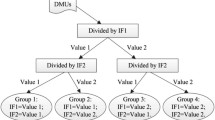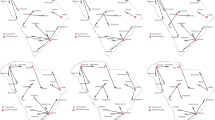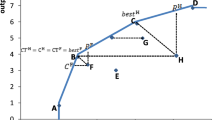Abstract
Data envelopment analysis models can be used to measure efficiency performance and yield an improvement target for the evaluated decision-making units. However, such models have not considered market factors. Demand fulfillment and resource management also matter in production. Sales losses due to insufficient stock or inventory holding costs happen when the production output of a factory is lower or higher than the market demand. Moreover, the cost of purchasing to cover shortages of a necessary resource or disposing of a surplus resource happens when the resource amount is lower or higher than the level required for production. In this study, we adopt the definition of penalized output used to quantify the mismatch between demand level and actual output, and we propose the concept of penalized input to deal further with mismatches between owned resources and actual input. We then develop an extended closest target setting model with both penalized input and penalized output to find a projection on the demand-truncated frontier with minimum improvement costs. Finally, two simple numerical examples are used to demonstrate the applicability and practicality of the proposed approach.





Similar content being viewed by others
References
Asmild M, Paradi JC, Reese DN, Tam F (2007) Measuring overall efficiency and effectiveness using DEA. Eur J Oper Res 178(1):305–321
Amirteimoori A, Kordrostami S (2010) A Euclidean distance-based measure of efficiency in data envelopment analysis. Optimization 59(7):985–996
Ang S, An Q, Yang F, Ji X (2019) Target setting with minimum improving costs in data envelopment analysis: a mixed integer linear programming approach. Expert Syst 36(4):e12408
Aparicio J, Cordero JM, Pastor JT (2017a) The determination of the least distance to the strongly efficient frontier in data envelopment analysis oriented models: modelling and computational aspects. Omega 71:1–10
Aparicio J, Garcia-Nove EM, Kapelko M, Pastor JT (2017b) Graph productivity change measure using the least distance to the Pareto-efficient frontier in data envelopment analysis. Omega 72:1–14
Aparicio J, Ortiz L, Pastor JT (2017c) Measuring and decomposing profit inefficiency through the Slacks-Based Measure. Eur J Oper Res 260(2):650–654
Aparicio J, Pastor JT, Vidal F, Zofío JL (2017d) Evaluating productive performance: a new approach based on the product-mix problem consistent with Data Envelopment Analysis. Omega 67:134–144
Aparicio J, Pastor JT (2014) Closest targets and strong monotonicity on the strongly efficient frontier in DEA. Omega 44:51–57
Aparicio J, Ruiz JL, Sirvent I (2007) Closest targets and minimum distance to the Pareto-efficient frontier in DEA. J Prod Anal 28(3):209–218
Beak C, Lee JD (2009) The relevance of DEA benchmarking information and the least-distance measure. Math Comput Model 49(1–2):265–275
Bogetoft P, Färe R, Obel B (2006) Allocative efficiency of technically inefficient production units. Eur J Oper Res 168(2):450–462
Briec W (1999) Hölder distance function and measurement of technical efficiency. J Prod Anal 11(2):111–131
Briec W, Lesourd JB (1999) Metric distance function and profit: some duality results. J Optim Theory Appl 101:15–33
Briec W, Lemaire B (1999) Technical efficiency and distance to a reverse convex set. Eur J Oper Res 114(1):178–187
Briec W, Leleu H (2003) Dual representations of non-parametric technologies and measurement of technical efficiency. J Prod Anal 20(1):71–96
Charnes A, Cooper WW, Rhodes E (1978) Measuring the efficiency of decision making units. Eur J Oper Res 2(6):429–444
Charnes A, Cooper WW, Golany B, Seiford L, Stutz J (1985) Foundations of data envelopment analysis for Pareto-Koopmans efficient empirical production functions. J Econ 30(1–2):91–107
Charnes A, Haag S, Jaska P, Semple J (1992) Sensitivity of efficiency classifications in the additive model of data envelopment analysis. Int J Syst Sci 23(5):789–798
Chen Y, Cook WD, Li N, Zhu J (2009) Additive efficiency decomposition in two-stage DEA. Eur J Oper Res 196(3):1170–1176
Du J, Liang L, Chen Y, Bi GB (2010) DEA-based production planning. Omega 38(1–2):105–112
Frei FX, Harker PT (1999) Projections onto efficient frontiers: theoretical and computational extensions to DEA. J Prod Anal 11(3):275–300
Fukuyama H, Maeda Y, Sekitani K, Shi J (2014) Input–output substitutability and strongly monotonic p-norm least distance DEA measures. Eur J Oper Res 237(3):997–1007
Gonzalez E, Alvarez A (2001) From efficiency measurement to efficiency improvement: the choice of a relevant benchmark. Eur J Oper Res 133(3):512–520
Golany B (1988) An interactive MOLP procedure for the extension of DEA to effectiveness analysis. J Oper Res Soc 39(8):725–734
Golany B, Phillips FY, Rousseau JJ (1993) Models for improved effectiveness based on DEA efficiency results. IIE Trans 25(6):2–10
Han H, Zhang X (2020) Static and dynamic cultivated land use efficiency in China: a minimum distance to strong efficient frontier approach. J Clean Prod 246:119002
Hatefi SM, Torabi SA (2010) A common weight MCDA–DEA approach to construct composite indicators. Ecol Econ 70(1):114–120
Hussein B, Moselhi O (2019) An evolutionary stochastic discrete time-cost trade-off method. Can J Civ Eng 46(7):581–600
Jin F, Garg H, Pei L, Liu J, Chen H (2020a) Multiplicative consistency adjustment model and data envelopment analysis-driven decision-making process with probabilistic hesitant fuzzy preference relations. Int J Fuzzy Syst 22(7):2319–2332
Jin F, Liu J, Zhou L, Martínez L (2021) Consensus-based linguistic distribution large-scale group decision making using statistical inference and regret theory. Group Decis Negot 30(4):813–845
Jin F, Pei L, Liu J, Zhou L, Chen H (2020b) Decision-making model with fuzzy preference relations based on consistency local adjustment strategy and DEA. Neural Comput Appl 32(15):11607–11620
Kao C, Hwang SN (2008) Efficiency decomposition in two-stage data envelopment analysis: an application to non-life insurance companies in Taiwan. Eur J Oper Res 185(1):418–429
Kerstens K, Van de Woestyne I (2021) Cost functions are nonconvex in the outputs when the technology is nonconvex: convexification is not harmless. Ann Oper Res 305(1):81–106
Lee CY (2014) Distinguishing operational performance in power production: a new measure of effectiveness by DEA. IEEE Trans Power Syst 30(6):3160–3167
Lee CY (2016) Most productive scale size versus demand fulfillment: A solution to the capacity dilemma. Eur J Oper Res 248(3):954–962
Lee CY, Johnson AL (2011) A decomposition of productivity change in the semiconductor manufacturing industry. Int J Prod Res 49(16):4761–4785
Lee CY, Johnson AL (2012) Two-dimensional efficiency decomposition to measure the demand effect in productivity analysis. Eur J Oper Res 216(3):584–593
Lee CY, Johnson AL (2014) Proactive data envelopment analysis: effective production and capacity expansion in stochastic environments. Eur J Oper Res 232(3):537–548
Lee CY, Johnson AL (2015) Effective production: measuring of the sales effect using data envelopment analysis. Ann Oper Res 235(1):453–486
Lozano S, Villa G (2005) Determining a sequence of targets in DEA. J Oper Res Soc 56(12):1439–1447
Lozano S, Villa G (2010) Gradual technical and scale efficiency improvement in DEA. Ann Oper Res 173:123–136
Li J, Huang Q, Li Y (2021) Stepwise improvement for environmental performance of transportation industry in China: a DEA approach based on closest targets. Math Prob Eng, 2021
Liu J, Shao L, Jin F, Tao Z (2022) A multi-attribute group decision-making method based on trust relationship and dea regret cross-efficiency. IEEE Trans Eng Manage
Ma H, Geng B, Fu Y, Sun Y, Sun Z (2022) Efficiency analysis of industrial water treatment in china based on two-stage undesirable fixed-sum output DEA model. J Syst Sci Inf 9(6):660–680
Morita H, Hirokawa K, Zhu J (2005) A slack-based measure of efficiency in context-dependent data envelopment analysis. Omega 33(4):357–362
Pastor JT, Aparicio J (2010) The relevance of DEA benchmarking information and the least-distance measure: comment. Math Comput Model 52(1–2):397–399
Pendharkar PC (2015) Cost minimizing target setting heuristics for making inefficient decision-making units efficient. Int J Prod Econ 162:1–12
Portela MCAS, Borges PC, Thanassoulis E (2003) Finding closest targets in non-oriented DEA models: the case of convex and non-convex technologies. J Prod Anal 19(2):251–269
Razipour-GhalehJough S, Lotfi FH, Jahanshahloo G, Rostamy-Malkhalifeh M, Sharafi H (2019) Finding closest target for bank branches in the presence of weight restrictions using data envelopment analysis. Ann Oper Res, 1–33
Ruiz JL, Sirvent I (2020) Searching for alternatives to the closest targets: identifying new directions for improvement while controlling additional efforts. J Oper Res Soc, pp 1–13
Sexton TR, Silkman RH, Hogan AJ (1986) Data envelopment analysis: Critique and extensions. New Directions Prog Eval 1986(32):73–105
Silva Portela MCA, Borges PC, Thanassoulis E (2003) Finding closest targets in non-oriented DEA models: the case of convex and non-convex technologies. J Prod Anal 19(2):251–269
Sun C, Ang S, Wei F, Yang F (2022) The max-reward and min-penalty frontier: A benchmark for research of supply and demand mismatches. J Oper Res Soc, pp 1–14. https://doi.org/10.1080/01605682.2022.2150575
Tone K (2001) A slacks-based measure of efficiency in data envelopment analysis. Eur J Oper Res 130(3):498–509
Tran DH (2020) Optimizing time–cost in generalized construction projects using multiple-objective social group optimization and multi-criteria decision-making methods. Eng Constr Archit Manag 27(9):2287–2313
Wang D, Wei F, Yang F (2023) Efficiency evaluation of a two-stage production process with feedback: an improved DEA model. INFOR Inf Syst Oper Res 61(1):67–85
Wang K, Lee CY, Zhang J, Wei YM (2018) Operational performance management of the power industry: a distinguishing analysis between effectiveness and efficiency. Ann Oper Res 268(1):513–537
Wang K, Zhang J, Wei YM (2017) Operational and environmental performance in China’s thermal power industry: taking an effectiveness measure as complement to an efficiency measure. J Environ Manage 192:254–270
Wang X, Lu K, Shi J, Hasuike T (2020) A new mip approach on the least distance problem in dea. Asia-Pacific J Oper Res 37(06):2050027
Yang J, Wu J, Li X, Zhu Q (2022) Sustainability performance analysis of environment innovation systems using a two-stage network DEA model with shared resources. Front Eng Manage 9(3):425–438
Zhu J (2001) Super-efficiency and DEA sensitivity analysis. Eur J Oper Res 129(2):443–455
Acknowledgements
The research is supported by the National Natural Science Foundation of China (Nos. 72101246, 71991464, 71921001, and 71601173), the China Postdoctoral Science Foundation (2019M662210), the Xin Wenke Program of University of Science and Technology of China (XWK2019029), and the Fundamental Research Funds for the Central Universities (Nos. JZ2023HGTB0286, WK2040000024, and WK2040000027).
Author information
Authors and Affiliations
Corresponding author
Ethics declarations
Conflict of interest
The authors declare that they have no known competing financial interests or personal relationships that could have appeared to influence the work reported in this paper.
Additional information
Publisher's Note
Springer Nature remains neutral with regard to jurisdictional claims in published maps and institutional affiliations.
Appendices
Appendix A
Charnes et al. (1985) proposed the additive model (ADD model), a third DEA model, to actually deal with least-norm projections to the frontier.
The ADD model aims to maximize the sum of slacks of inputs and outputs thus to find a target on the frontier with the greatest improvement in both inputs and outputs. Letting \(\left({\lambda }_{j}^{*},{s}_{i}^{-*},{s}_{r}^{+*}\right)\) be the optimal solution of above model when \({\text{DMU}}_{k}\) is evaluated, then we have:
Definition A1:
\({\text{DMU}}_{k}\) is Pareto–Koopmans efficient if and only if \({s}_{ik}^{-*}=0\) and \({s}_{rk}^{+*}=0\) for \(i=1,\dots ,m\) and \(r=1,\dots ,s\).
Appendix B: Closest target setting in FDH technologies
Based on mADD model, which is formulated by using the non-convexity axiom, model (13) in our study is expressed as output-oriented formulation. In many practical situations, however, it is desirable to use measures of efficiency that are non-oriented and non-radial in character (Silva et al., 2003; Kerstens and Van de Woestyne, 2021). So here, we develop a second non-oriented and non-radial model to find closest target on demand-truncated frontier in Free Disposal Hull (FDH) technologies.
We add an additional constraint \({\lambda }_{j}=\{\text{0,1}\}\) to exhibit non-convexity and variable returns to scale (VRS). The objective function is still to minimize the overall improvement costs to demand-truncated frontier. And penalized inputs and penalized outputs of evaluated DMU are still used to incorporate supply and demand information.
Here, E still represents the set of efficient DMUs and the marginal cost vectors for reducing input and increasing output are \({\left({c}_{1}^{I},\dots ,{c}_{m}^{I}\right)}^{T}>{0}_{m}\) and \({\left({c}_{1}^{o},\dots ,{c}_{s}^{o}\right)}^{T}>{0}_{{\varvec{s}}}\), respectively. The target projection is limited under demand lines, that is, the output of target is no greater than its corresponding demand level.
Rights and permissions
Springer Nature or its licensor (e.g. a society or other partner) holds exclusive rights to this article under a publishing agreement with the author(s) or other rightsholder(s); author self-archiving of the accepted manuscript version of this article is solely governed by the terms of such publishing agreement and applicable law.
About this article
Cite this article
Wei, F., Fu, Y., Yang, F. et al. Closest target setting with minimum improvement costs considering demand and resource mismatches. Oper Res Int J 23, 42 (2023). https://doi.org/10.1007/s12351-023-00783-9
Received:
Revised:
Accepted:
Published:
DOI: https://doi.org/10.1007/s12351-023-00783-9




